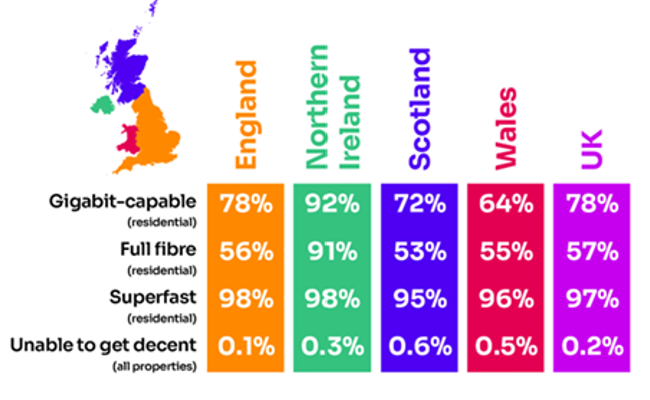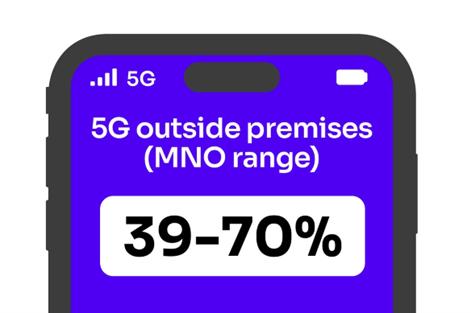
- 53% of Scottish homes now have access to full-fibre, up from 41% last year
- 5G mobile coverage in Scotland continues to grow rapidly
A record 1.4 million homes – over half of all residential premises – now have access to full-fibre broadband in Scotland, according to Ofcom’s latest Connected Nations report published today.
Full-fibre broadband uses fibre all the way to your home. It is more reliable and resilient than copper, and our new analysis shows that some providers experience fewer faults [1] on their fibre network compared with a copper-based network. Gigabit capable networks, which include both full fibre and cable, also deliver faster upload and download speeds that make for a better experience when gaming, working and video calling.
For the first time, full-fibre broadband is available to over half of homes in all four of the UK nations. Northern Ireland leads the way, with over nine in 10 homes (91%) able to get full fibre. In Scotland, over half (53%) of homes now have access to full-fibre broadband, up from 41% last year.

Overall, 28% of homes and businesses that can access full fibre in Scotland have taken it up, in line with the levels of take-up across the UK.
Gigabit capable broadband is now available at over seven-in-10 (72%) Scottish homes, with superfast broadband – providing download speeds of at least 30 Mbit/s – available to 95% of residential properties.
The rollout of full-fibre broadband reaching over half of Scotland’s residential properties represents a significant milestone, enabling faster and more resilient connectivity for hundreds of thousands of customers. Both fixed broadband and mobile connectivity across Scotland are continuing to improve and offer those benefits to communities across the country.
Glenn Preston, Ofcom’s Scotland Director
There’s been a further reduction in the number of homes and businesses in Scotland unable to access ‘decent’ [2] broadband in the last year, decreasing by 14% to 18,000 premises. Additionally, more homes across the UK are taking up satellite broadband in rural areas of the country, with around 42,000 customers connected to Starlink’s satellite service (up from 13,000 last year).
Rollout of 5G mobile gathers pace in Scotland, as geographic coverage improves
The availability of 5G continues to grow rapidly, with estimated coverage provided outside of Scottish premises by at least one mobile network operator of 80% – a rise on last year’s 57%. Scotland has the second highest range of 5G coverage outside premises across individual operators (at 39-70%) [3] of the four UK nations.

The majority of mobile traffic in the UK continues to be carried over 4G, accounting for over four fifths (81%) of total data traffic. There has been a small but notable increase in 4G coverage across Scotland’s landmass, with 84% able to access it from at least one mobile network operator, up from 83% in 2022. 4G coverage from all four operators is available across nearly half (48%) of Scotland, up from 46% in 2022, delivering enhanced mobile connectivity in particular to rural communities.
Across the UK, mobile network operators are starting to switch off their 3G networks, with EE, Vodafone and Three planning on doing so next year followed by Virgin Media O2 in 2025. Ofcom data shows that there are around 2.4 million devices in the UK still reliant on 2G or 3G networks, which has more than halved from last year’s estimated 5.5 million. Of all network data traffic, just 3% is used by 3G, which has decreased by over two fifths (44%) year on year.
Ofcom continues its work to ensure consumers are treated fairly and that disruption is minimised during the 3G switch-off process. Mobile users who are still dependent on 3G can read Ofcom’s guide.
Notes:
- Over the last three years, for both KCOM and Openreach, the fault rate (per 1,000 connections) on KCOM‘s copper access network (ADSL) and Openreach‘s copper access networks (ADSL / VDSL) was around 50% higher than the fault rates on their respective FTTP networks.
- ‘Decent’ broadband is defined by the Government as delivering at least 10 Mbit/s download and 1 Mbit/s upload speeds.
- Refers to very high confidence of 5G coverage outside of premises in Scotland from individual mobile network operators.
